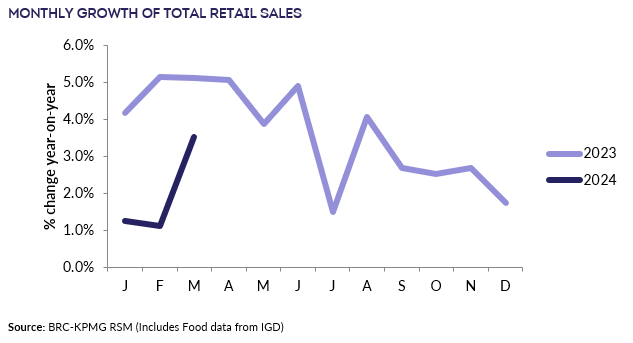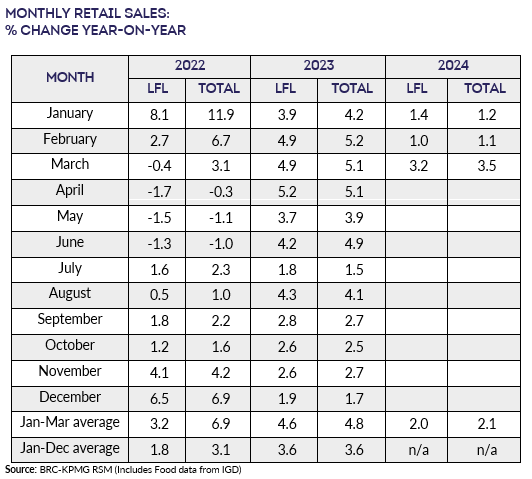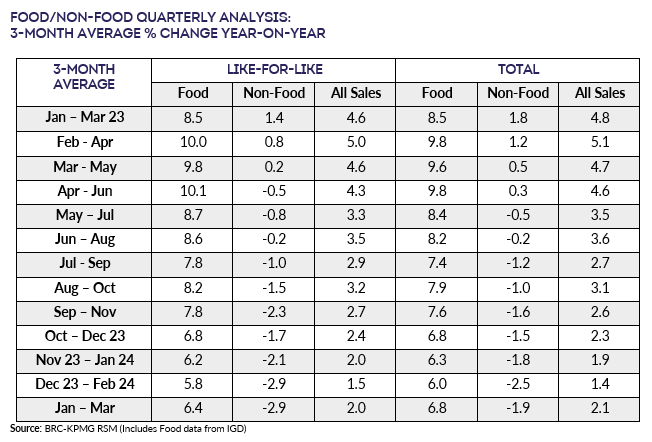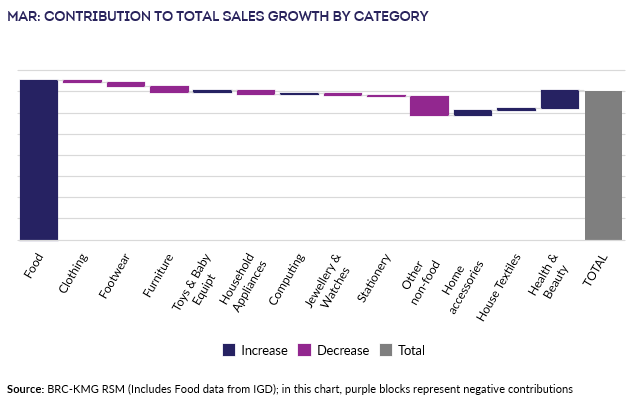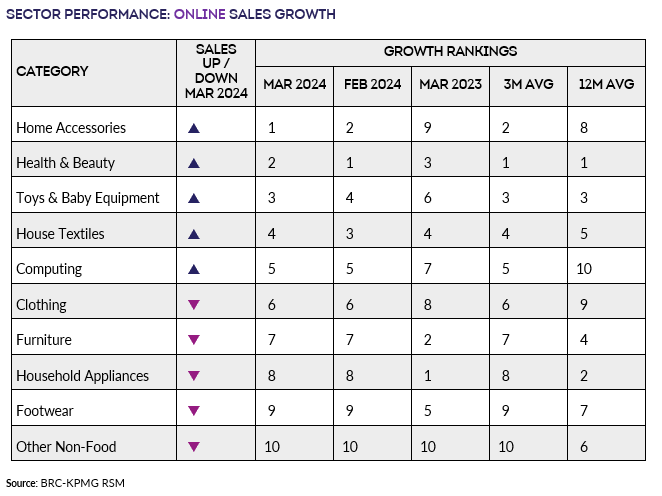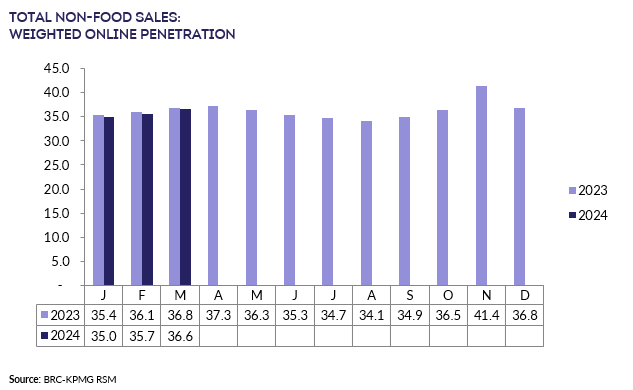Covering the five weeks 25 February – 30 March
2024
-
UK Total retail sales
increased by 3.5% year on year in March, against a growth of
5.1% in March 2023. This was above the 3-month average growth
of 2.1% and the 12-month average growth of 2.9%.
-
Food sales increased 6.8% year on year over
the three months to March, against a growth of 8.5% in March
2023. This is below the 12-month average growth of 7.7%. For
the month of March, Food was in growth year-on-year.
-
Non-Food sales decreased 1.9% year on year
over the three-months to March, against a growth of 1.8% in
March 2023. This is steeper than the 12-month average decline
of 1.1%. For the month of March, Non-Food was in decline
year-on-year.
-
In-store Non-Food sales over the three months
to March decreased 1.1% year on year, against a growth of 5.2%
in March 2023. This is below the 12-month average of 0.0%.
-
Online Non-Food sales decreased by 1.4% year
on year in March, against a decline of 2.1% in March 2023. This
was shallower than the 3-month and 12-month declines of 3.1%
and 2.8% respectively.
- The online penetration rate (the proportion of Non-Food items
bought online) decreased to 36.6% in March from 36.8% in March
2023. This was higher than the 12-month average of 36.2%.
Helen Dickinson OBE, Chief Executive
of the British Retail Consortium, said:
“While retail sales growth improved last month, this was largely
driven by Easter falling unusually early and the subsequent
uplift to food sales in the week preceding the long weekend.
Easter also boosted sales of non-food products such as cookware
and tableware, as people readied themselves to host family and
friends. Home textiles such as throws and pillows were also
popular as consumers sought to spruce up their homes ahead of
Spring. Elsewhere, wet weather dampened sales of garden
furniture, BBQs, DIY products, and clothing and footwear.
“After a difficult start to the year, retailers are hopeful that
with warmer weather around the corner, consumer confidence will
spring back up. A strong retail industry can boost investment
across our towns and cities, and as we gear up for a general
election, it is essential the next government recognises this and
rethinks the burdensome costs imposed on retailers. With a
pro-growth policy landscape, retailers can step up their
investment in innovation and in local jobs and communities up and
down the country.”
Linda Ellett, UK Head of Consumer Markets, Leisure &
Retail, KPMG, said:
“An early Easter showed green shoots of spring for retailers in
March, with sales growth up a more positive 3.5% on last year,
and above headline inflation for the first time in more than two
years.
“High street sales growth was driven by food and drink, health
and beauty and keen gardeners who headed outside to enjoy the
first days of spring. There were also some signs of
improvement with more categories starting to see positive sales
growth in March for the first time in months. Online sales,
however, continued to slide, falling by 1.4% despite strong
performances in home accessories, health, beauty, and homewares.
“As April signals big increases in the sector's cost base –
through the rise in minimum wage rates and business rate hikes
for the larger high street brands – retailers will be hoping that
the bounce back of March sales is more than just an Easter
blip. Economic indicators are heading in the right
direction with inflationary pressures easing and interest rates
having potentially peaked, however consumer confidence remains
fragile, and households continue to keep a close eye on where
their tight budgets are being spent. It remains a
challenging environment, but as we head into the warmer months,
retailers will be hoping that stronger consumer confidence will
turn into stronger retail sales, especially in more discretionary
categories such as clothing, following an incredibly difficult
few years.”
Food & Drink sector performance | Sarah Bradbury,
CEO, IGD, said:
“The UK grocery market benefitted from Easter falling in March
this year. This has led to very positive comparisons with
spending increasing on March 2023, and importantly significant
volume growth. This marks the fourth consecutive month of
year-on-year volume growth, offering hope to retailers and
suppliers of finally being able to regrow margins that have
shrunk during the cost-of-living crisis.
“Shoppers faced a multitude of financial changes this month from
the anticipation of ‘price hike Monday' to the budget
announcement that cut National Insurance for the second time in
six months. At a total level, shoppers have a growing confidence
in their financial outlook, however the strength of this growth
varies by household income. For lower income households,
confidence is growing at a slower rate despite news of an almost
10% increase to the national living wage. For all shoppers, we
expect the cautious approach to continue as cost-of-living
challenges remain.”
